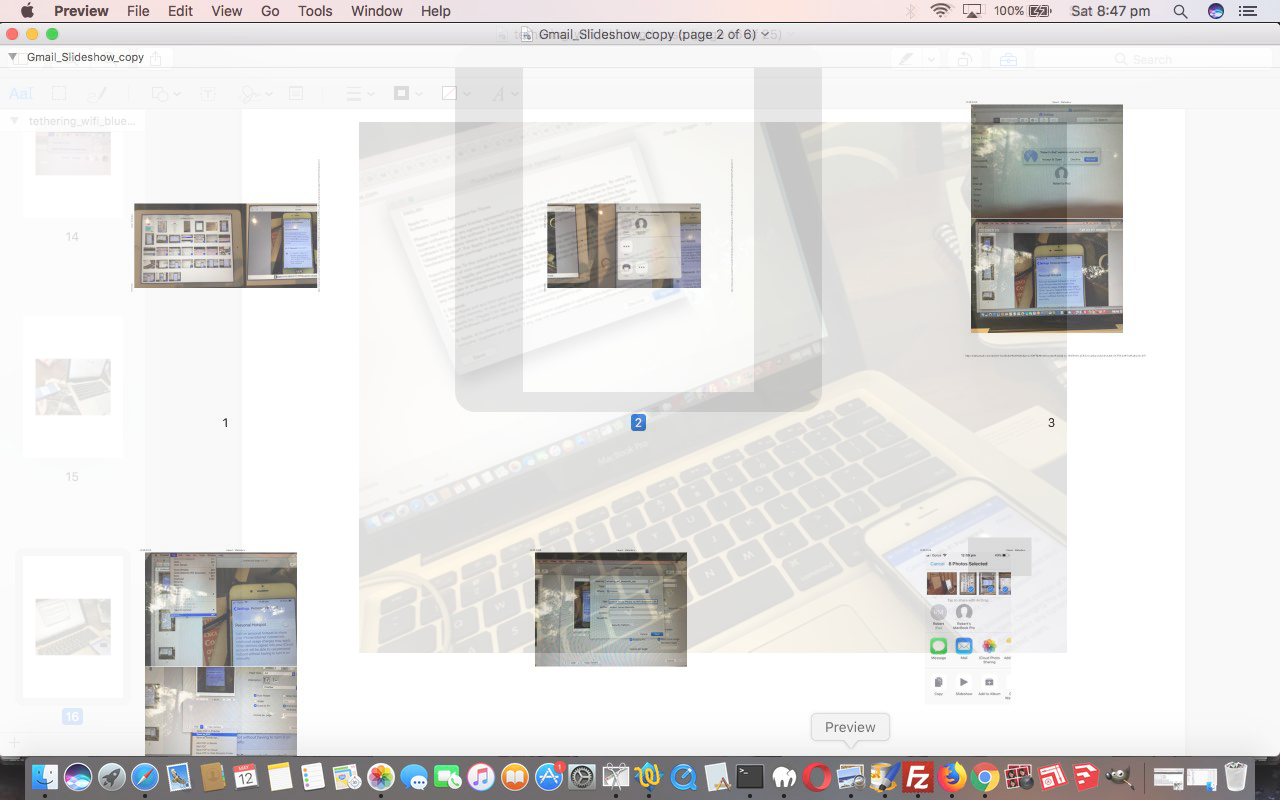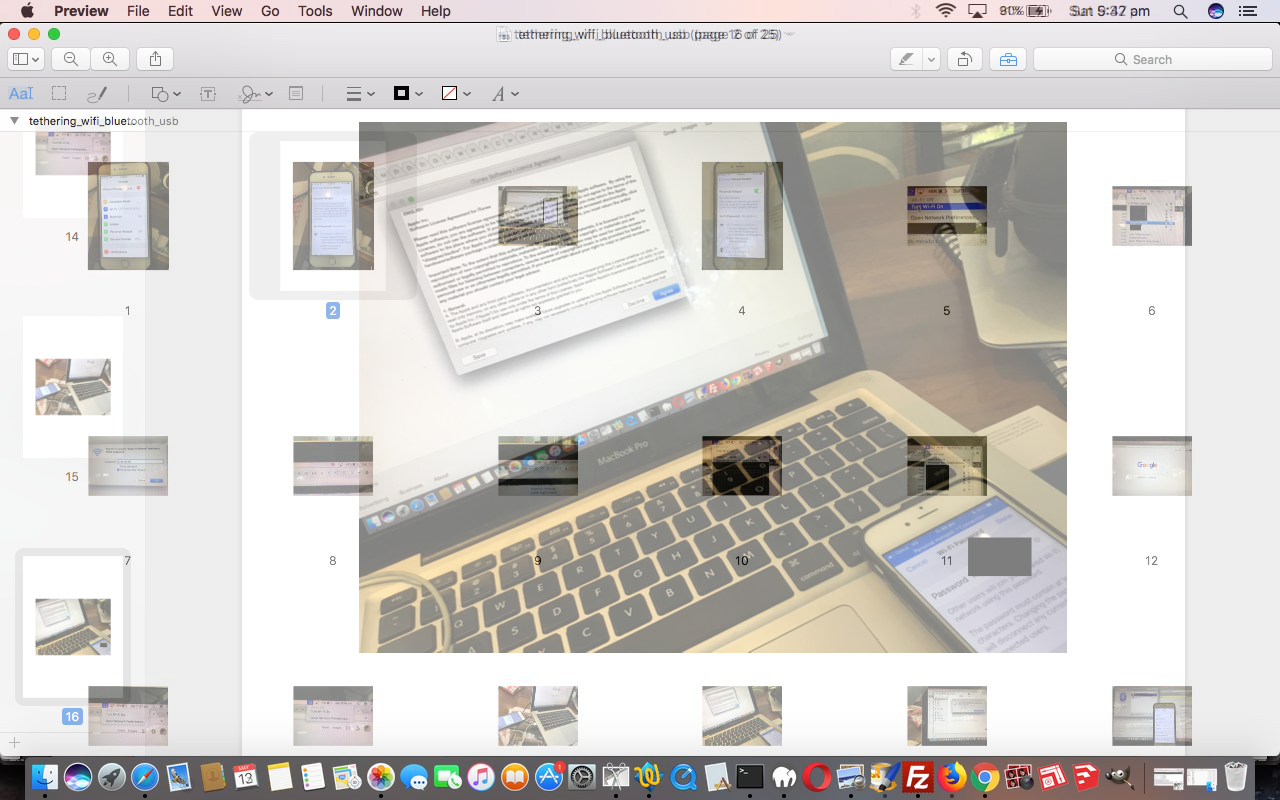The making of yesterday’s Tethering MacBook Pro to iPhone Primer Tutorial‘s PDF slideshow presentation was of great significance to us, because, although we’d had some experience with Mac OS X and iOS’s AirDrop means of sharing data before, when we presented AirDrop Primer Tutorial almost a year ago now, we remember the AirDrop scenario was not involving a large amount of data as yesterday’s PDF presentation of more than 20 “dense” photos involved, as well as the fact being that when AirDrop “sings” it really is so much faster than other data transfer methods, it feels to us after today’s work.
So what was the “lead in” to …
- needing to transfer … and …
- choosing to use (Apple’s) AirDrop as a means to data transfer
? Well, there was a third player to yesterday’s proceedings …
Mister Ed … sorry …MacBook Pro (named Robert’s MacBook Pro) … “tethered” to …Wilbur Post’s stable … sorry …iPhone (named Robert’s iPhone) … and photographed by …- iPad … Camera app in Photo mode of use
… and so having finished PDF slideshow presentation data capture, we had the task of transferring 25 “dense” iPad photos over to the MacBook Pro (where we use Finder -> Select Slides -> Preview -> Some Slideshow (Tools menu) Rotations and Reordering of Slides (via drag and drop) and (for first time for us today we use Tools -> Annotate -> Rectangle (with thick lines) to mask out some information) -> (File menu) Print -> (PDF dropdown) Save As PDF…) by some means or other … and as many readers will know the Email option is good for a few photos but not 25 … so … eyes shut (we have a chequered history with) … AirDrop becomes the best option. Lo and behold it was brilliant, saving us heaps of bother and time.
What we’d say about using AirDrop is this. Once you get to it, on the two Apple computers and/or devices involved you’ll be prompted in new windows to allow access, so our advice is to stay alert to this, but more or less “follow your nose”. What is very interesting about AirDrop is its integration into Mac OS X and/or iOS “ways”. It can either “turn up” or “be actively accessed by you, the user” via …
- turn up in Mac OS X’s Finder application
- in iOS, swiping from the bottom of the device, up
- in Photos app, in either Mac OS X or iOS, be one of the Sharing (rectangle to top arrow up icon) options
… as you can see a bit of at the start of today’s (new) PDF slideshow presentation, before it goes onto some Mac OS X Preview creation of this very PDF slideshow presentation … is that the “Making of the Making of …”?!
You can also see this play out at WordPress 4.1.1’s Making of Tethering MacBook Pro to iPhone AirDrop Tutorial.
Previous relevant Tethering MacBook Pro to iPhone Primer Tutorial is shown below.
Today we talk about a networking topic, regarding the idea if you are out and about, out of reach of WiFi connections, with your laptop, notebook or MacBook Pro, but you have available to you a device such as an Android or iPhone or iPad or tablet with inbuilt SIM card network connector, that networks via a mobile network (eg. here in Australia a 4G (soon to go to 5G) network) you (and we) can, perhaps …
- “tether” your laptop, notebook or MacBook Pro (Robert’s MacBook Pro) … to that …
- Android or iPhone (Robert’s iPhone) or iPad or tablet with inbuilt SIM card network connector accessing its mobile network (such as, here in Australia, 4G (soon to become 5G))
No, our MacBook Pro is not Mister Ed, but we do form a “stable” connection … chortle, chortle.
The clue to all this is, for us, in the iPhone’s …
Settings -> Personal Hotspot -> switch on
… and there you will see three modes of “hotspotting” …
- WiFi
- Bluetooth … enable on both and “Pair” on both
- USB … we use in Xcode running and testing mobile applications on iPhone (or iPad)
… the first of which is great with that scenario we talked about at the top of the article.
- be on iPhone and touch Settings icon
- touch Personal Hotspot
- touch to be On
- over at MacBook Pro and click Settings icon
- click WiFi
- pick Robert’s iPhone (or equivalent) in the list and it will have that “tethering” icon (two linked ellipses)
- voila! … you can surf the net, read your emails and do any of those other “online” activities … but be aware that this arrangement usually costs more in service charges
You can take a look at our PDF slideshow presentation of some of these concepts.
If this was interesting you may be interested in this too.
If this was interesting you may be interested in this too.




